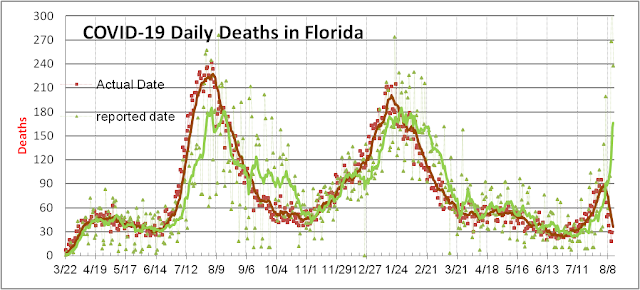COVID-19 Reporting Issues – Bigger than FL and CDC
COVID-19 data tracking and reporting has been problematic from day 1. Outdated systems and procedures made it difficult to understand the severity of the pandemic in its early days and handicapped the US efforts to control it. President Trump in a fit of pique and for political reasons decided to bypass the Center for Disease Control (CDC) for COVID-19 reporting and shift it to another department in Health and Human services (HHS) on July 15th, 2000. This has turned out poorly because while the CDC had problems, the HHS had no experience with tracking and reporting infectious diseases. While this helped Trump in the short term politically because the HHS was more willing to alter the data to fit the President’s message it hurt the US pandemic response long term. The President should have spent money on improving the existing CDC system instead of building another parallel system to monitor COVID-19.
Have things improved in 2021? The recent miscues in reporting cases and deaths from the Florida Department of Health (FL-DOH) to the CDC say no. It turns out that there is another way that FL COVID-19 deaths were tracked by the HHS on its HealthData.gov website. Since July 2020, HHS has compiled COVID-19 deaths as reported by all the hospitals in the USA. In its early days it was incomplete – possibly because many COVID-19 deaths occurred outside of hospitals – in nursing homes, prisons, private homes, etc. But for the current wave HHS has been tracking FL deaths better. HHS (red curve in the graph below) appears to tracks about 90% of all deaths compared to the blue curve which tracks deaths on an actual date basis as now reported to the CDC. It tracks quicker with just 2-3 days delay from the actual date of death – unlike the green curve which counts deaths as actually reported but delayed by 2 weeks of massaging (formerly reported by the FL-DOH to the CDC). It tracks the actual shape of the growth in death that cursory examination of the blue curve would distort. So if the Governor of Florida was trying to manage the narrative he forgot that the HHS death time series would have undercut that story – deaths are really soaring in FL as they are in TX, GA and most other states.
So is the HHS system better than the HHS system?
No, because while it has the best hospitalization data its data
on COVID-19 cases and deaths are incomplete. We had actually begun this study
to see whether there were as many deaths occurring outside of the hospital
system as there had been in prior waves.
The fact that there haven’t been is somewhat surprising (perhaps due to the
ferocity of Delta), but does not obviate the need for the more complete count
done by the CDC. Even that could be
improved since substantial evidence exists that deaths in excess of
what is normally expected every year has occurred above and beyond what the
CDC has counted as confirmed and suspected COVID-19 deaths.
The USA should be
investing in a single centralized data system that captures accurate, timely
and consistent infectious disease data from all states. Data validation systems (using A/I and
machine learning) can identify attempts to pass inconsistent or incomplete data
so that only clean data is presented to the public and given to scientists for detailed
analysis. CDC should provide state of the
art data extraction and reporting tools for that one system instead of building
two expensive half-baked systems. Trying
to manipulate or manage the data will ultimately be futile creating short term
confusion and long term distrust of data and science and the go




Comments
Post a Comment